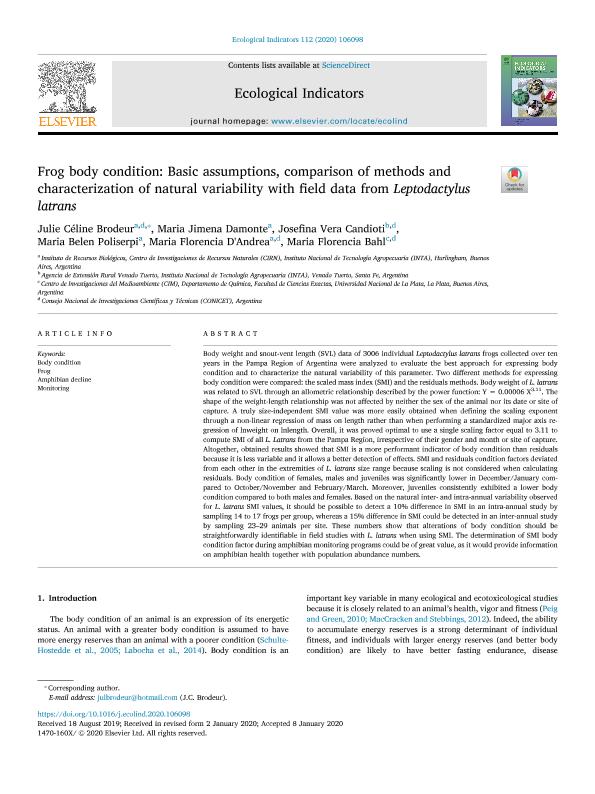Mostrar el registro sencillo del ítem
dc.contributor.author
Brodeur, Celine Marie Julie

dc.contributor.author
Damonte, Maria Jimena

dc.contributor.author
Vera Candioti, Josefina

dc.contributor.author
Poliserpi, Maria Belen

dc.contributor.author
D'Andrea, Maria Florencia
dc.contributor.author
Bahl, Maria Florencia

dc.date.available
2021-05-17T18:57:52Z
dc.date.issued
2020-05
dc.identifier.citation
Brodeur, Celine Marie Julie; Damonte, Maria Jimena; Vera Candioti, Josefina; Poliserpi, Maria Belen; D'Andrea, Maria Florencia; et al.; Frog body condition: Basic assumptions, comparison of methods and characterization of natural variability with field data from Leptodactylus latrans; Elsevier Science; Ecological Indicators; 112; 5-2020; 1-9
dc.identifier.issn
1470-160X
dc.identifier.uri
http://hdl.handle.net/11336/132177
dc.description.abstract
Body weight and snout-vent length (SVL) data of 3006 individual Leptodactylus latrans frogs collected over ten years in the Pampa Region of Argentina were analyzed to evaluate the best approach for expressing body condition and to characterize the natural variability of this parameter. Two different methods for expressing body condition were compared: the scaled mass index (SMI) and the residuals methods. Body weight of L. latrans was related to SVL through an allometric relationship described by the power function: Y = 0.00006 X3.11. The shape of the weight-length relationship was not affected by neither the sex of the animal nor its date or site of capture. A truly size-independent SMI value was more easily obtained when defining the scaling exponent through a non-linear regression of mass on length rather than when performing a standardized major axis regression of lnweight on lnlength. Overall, it was proved optimal to use a single scaling factor equal to 3.11 to compute SMI of all L. Latrans from the Pampa Region, irrespective of their gender and month or site of capture. Altogether, obtained results showed that SMI is a more performant indicator of body condition than residuals because it is less variable and it allows a better detection of effects. SMI and residuals condition factors deviated from each other in the extremities of L. latrans size range because scaling is not considered when calculating residuals. Body condition of females, males and juveniles was significantly lower in December/January compared to October/November and February/March. Moreover, juveniles consistently exhibited a lower body condition compared to both males and females. Based on the natural inter- and intra-annual variability observed for L. latrans SMI values, it should be possible to detect a 10% difference in SMI in an intra-annual study by sampling 14 to 17 frogs per group, whereas a 15% difference in SMI could be detected in an inter-annual study by sampling 23–29 animals per site. These numbers show that alterations of body condition should be straightforwardly identifiable in field studies with L. latrans when using SMI. The determination of SMI body condition factor during amphibian monitoring programs could be of great value, as it would provide information on amphibian health together with population abundance numbers.
dc.format
application/pdf
dc.language.iso
eng
dc.publisher
Elsevier Science

dc.rights
info:eu-repo/semantics/openAccess
dc.rights.uri
https://creativecommons.org/licenses/by-nc-nd/2.5/ar/
dc.subject
AMPHIBIAN DECLINE
dc.subject
BODY CONDITION
dc.subject
FROG
dc.subject
MONITORING
dc.subject.classification
Ecología

dc.subject.classification
Ciencias Biológicas

dc.subject.classification
CIENCIAS NATURALES Y EXACTAS

dc.title
Frog body condition: Basic assumptions, comparison of methods and characterization of natural variability with field data from Leptodactylus latrans
dc.type
info:eu-repo/semantics/article
dc.type
info:ar-repo/semantics/artículo
dc.type
info:eu-repo/semantics/publishedVersion
dc.date.updated
2021-05-11T18:27:18Z
dc.journal.volume
112
dc.journal.pagination
1-9
dc.journal.pais
Países Bajos

dc.journal.ciudad
Amsterdam
dc.description.fil
Fil: Brodeur, Celine Marie Julie. Instituto Nacional de Tecnología Agropecuaria. Centro de Investigación de Recursos Naturales. Instituto de Recursos Biológicos; Argentina. Consejo Nacional de Investigaciones Científicas y Técnicas; Argentina
dc.description.fil
Fil: Damonte, Maria Jimena. Instituto Nacional de Tecnología Agropecuaria. Centro de Investigación de Recursos Naturales. Instituto de Recursos Biológicos; Argentina
dc.description.fil
Fil: Vera Candioti, Josefina. Instituto Nacional de Tecnología Agropecuaria. Centro Regional Santa Fe. Estación Experimental Agropecuaria Oliveros. Agencia de Extension Rural Venado Tuerto; Argentina. Consejo Nacional de Investigaciones Científicas y Técnicas; Argentina
dc.description.fil
Fil: Poliserpi, Maria Belen. Instituto Nacional de Tecnología Agropecuaria. Centro de Investigación de Recursos Naturales. Instituto de Recursos Biológicos; Argentina
dc.description.fil
Fil: D'Andrea, Maria Florencia. Consejo Nacional de Investigaciones Científicas y Técnicas; Argentina. Instituto Nacional de Tecnología Agropecuaria. Centro de Investigación de Recursos Naturales. Instituto de Recursos Biológicos; Argentina
dc.description.fil
Fil: Bahl, Maria Florencia. Universidad Nacional de La Plata. Facultad de Ciencias Exactas. Departamento de Química. Centro de Investigaciones del Medio Ambiente; Argentina. Consejo Nacional de Investigaciones Científicas y Técnicas; Argentina
dc.journal.title
Ecological Indicators

dc.relation.alternativeid
info:eu-repo/semantics/altIdentifier/url/https://linkinghub.elsevier.com/retrieve/pii/S1470160X20300352
dc.relation.alternativeid
info:eu-repo/semantics/altIdentifier/doi/http://dx.doi.org/10.1016/j.ecolind.2020.106098
Archivos asociados
